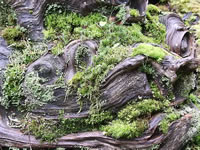Moss Gardening
|
||||
|
||||
|
They make an excellent ground cover for shade gardens, accents for rock gardens and water features, and are a low-maintenance alternative to grass lawns. Mosses will grow on rocks, between paving stones, over logs, in soil, or any shady spot where other plants won't grow. The compact nature and slow growth of many mosses make them very usable for creating a beautiful indoor landscape in a terrarium! Growing Requirements of MossThere are four factors that will determine your success or failure at growing moss in your landscape.Moss requires acid soil, shading, sufficient moisture, and humidity. Soil pH
Mosses prefer acidic soils with a pH between 5.0 and 6.0. They will probably not survive if the pH is higher than 6.5! (Testing kits are available at most nurseries and home centers. They are inexpensive and easy to use easy to use...) The pH can be adjusted by the addition of sulfur (liquid or granular) or peat moss to the soil prior to planting. Shading
Most mosses prefer a medium to fairly dense shade. A bit of morning sun will help to intensify the color of the moss but direct, hot afternoon sun will burn it. Very few mosses will survive in full sun. The ideal growing locations are northern or eastern facing slopes or wooded areas. When choosing the planting area, be sure to consider the sun's location during all four seasons. (An area that is fully shaded now may be in full sun by mid summer!) Sufficient Moisture
Once established, moss will tolerate periods of drought, but it prefers constant moisture. However, if the moss is to survive, it is absolutely imperative that the area is kept constantly moist for at least the first three weeks following transplanting. Humidity
Because moss obtains its nutrients from the air, humidity is very important, but it is very hard to control. If the area is kept moist enough there will naturally be a certain amount of humidity in the growing zone. Water features will increase the humidity in the immediate area of the feature, but the best method is probably to install an automated misting system.
Where to Get MossUnfortunately, at this time there are not many different types of moss available for sale.Many nurseries don't carry it at all..... The easiest way to acquire moss for the garden is to transplant a strip from your own or a neighbor's woods (With their permission, of course!). It is best to remove the moss attached to a layer of the material it is already growing on to avoid excess damage to the protonema. I use a square shovel to cut the edges of the patch I am after, then try to scoop an inch of soil with the moss. Mosses which grow on rotting wood will most likely require a rotting wood surface to survive. If possible, remove it still attached to the wood or gather some of the rotted material for the planting area. If all else fails it will probably grow for you on packed garden bark mulch. Remove moss from rocks carefully, with a wide putty knife. Propagating MossTake a clump of healthy moss and crumble it into your blender.Add 2 cups of buttermilk and 2 cups of water Blend at the lowest speed until it is completely mixed and the consistency of a thin milk shake. (add water if necessary) Paint the mixture onto rocks, pots or statuary, or simply pour it on the ground wherever you'd like your moss to grow!
|
||||
Search The Garden Helper:

